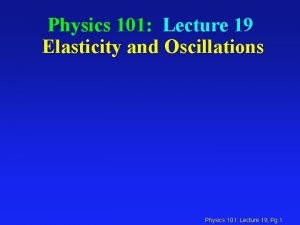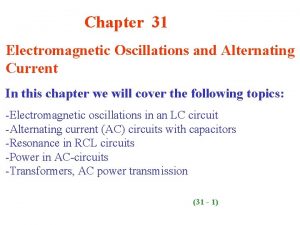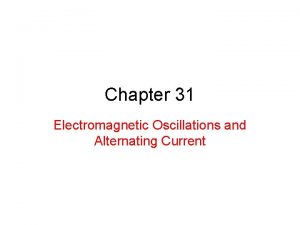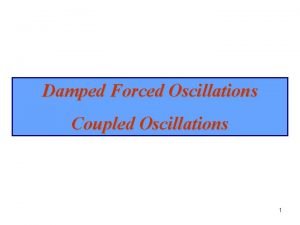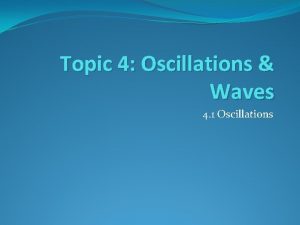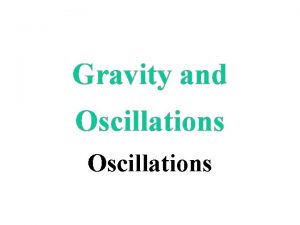Oscillations and Waves Topic 4 3 Forced oscillations












- Slides: 12

Oscillations and Waves Topic 4. 3 Forced oscillations and resonance

Damped oscillations • When a system executes true SHM then 1. Its period is independent of its amplitude 2. Its total energy remains constant in time • In practice many bodies execute approximate SHM because 1. F is not proportional to x 2. The energy of the system decreases in time Total energy E / J Dissipated energy Energy of system Time / s

Damping • Damping is caused my dissipative forces, such as air viscosity, and work is taken from the energy of oscillation. • Damping is the process whereby energy is taken from the oscillating system • For example a playground swing – If you push it will oscillate – It will eventually slow down as energy is lost to friction – Energy needs to be supplied to keep it oscillating, that comes from you!

Types of damping 1 • Slight damping x/m t/s • This results in a definite oscillation, but the amplitude decays exponentially

Types of damping 2 • Critical damping x/m t/s T/4 • No real oscillation, the time taken for displacement to become zero is a minimum

Types of damping 3 • Heavy damping x/m Very slow return to zero displacement t/s • Damping force is much greater than the critical damping. The system returns to zero very slowly

Natural oscillations • The oscillations so far have been free oscillations, or natural oscillations, which the system has been given some energy and left alone. • The frequency of oscillation depends on the inertia and elasticity factors of the system • For example – Guitar string, it will always play the same notes regardless of how hard you pluck it – A child’s swing, it will always swing at the same rate regardless of how faster you push it • This is called the natural frequency, f 0

Forced oscillations • Previously the oscillations have been given a single push to start them moving • Often oscillations are subjected to a constant force, called the driving force, f • The effect that the driving for has depends on its frequency

Effects of forced oscillations • • • The damping of the system has these effects: Amplitude – The amplitude is decreases with damping (cuts down the sharp peak) – The maximum amplitude is at a frequency less than the natural frequency Energy – The power of the driver is controlled by damping

Resonance • • Resonance occurs when the an oscillator is acted upon by a driving force that has the same frequency as the natural frequency The driving force easily transfers its energy to the oscillator From the picture the amplitude of oscillation will become very high This can be a useful and sometimes very bad

Useful resonance • Electricity, tuning a radio – The natural frequency of the radio circuit is made equal to the incoming electromagnetic wave by changing its capacitance – The electrons in the circuit will oscillate with the incoming electromagnetic wave. – The electric current will oscillate and this can be turned into sound, through a speaker • Microwave ovens – Microwaves are produced at the same frequency as the natural frequency of water molecules – Water molecules absorb the energy from the microwaves and transfer their energy to the food in the form of thermal energy

When resonance goes bad • A Driving force at resonance increases the oscillations, sometimes this is unwanted • Structures – Tacoma Narrows bridge, this bridge was destroyed as the wind (driving force) was at the same as the natural frequency. The bridge vibrated and shook itself apart – Tower blocks, the same effect as the bridge the wind, or earthquakes, can cause vibrations to destroy the buildings This can be stopped by designing the building with heavy damping – High stiffness – Large mass – Shape – Good at absorbing energy
 Compare and contrast p waves and s waves using venn diagram
Compare and contrast p waves and s waves using venn diagram Transverse waves move perpendicular
Transverse waves move perpendicular What are the mechanical waves
What are the mechanical waves Mechanical waves and electromagnetic waves similarities
Mechanical waves and electromagnetic waves similarities Carbon dioxide temperature
Carbon dioxide temperature Difference between matter waves and electromagnetic waves
Difference between matter waves and electromagnetic waves Mechanical and electromagnetic waves similarities
Mechanical and electromagnetic waves similarities Surface waves and body waves
Surface waves and body waves Venn diagram of mechanical and electromagnetic waves
Venn diagram of mechanical and electromagnetic waves Aimtoknow
Aimtoknow Elasticity and oscillations
Elasticity and oscillations Electromagnetic oscillations and alternating current
Electromagnetic oscillations and alternating current Electromagnetic oscillation pdf
Electromagnetic oscillation pdf










